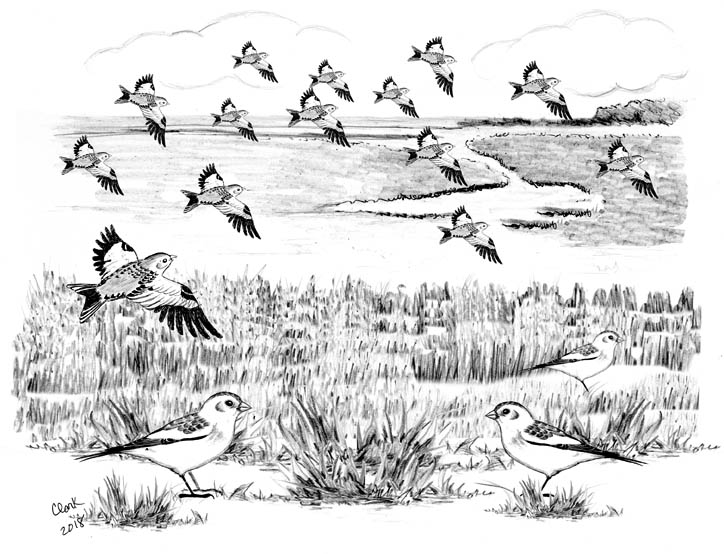
What are you looking at? – Chris, Harwich, MA
I don’t want any trouble, Chris,
“What are you looking at?” is usually a line heard in a movie, just before a barroom brawl breaks out. But in this case, it was a friendly inquiry from Chris, whom I recently met in the parking lot of Eastham’s First Encounter Beach. I was busy chasing down a flock of Snow Buntings and Chris, and his fancy camera, were focused on something else. I’ll tell you what Chris was looking at later, but first I want to talk about Snow Buntings. After all, they are the birds I was looking for and since it’s my column, my birds get mentioned first.
Snow Buntings are as adorable as their name suggests. But these little white, brown and black sparrow-sized birds are no sissies. They breed farther north than any other songbird in the world. How far north, you ask? (Even if you didn’t ask, just go along with me.) Some Snow Buntings breed north of Alaska and even north of Canada. Really. Snow Buntings can be found each summer building their nests on the northern edges of Greenland, right up there with walruses, musk ox and Rudolph.
Because the High Arctic is virtually treeless, most breeding birds are forced to build their nests on the ground, which makes them vulnerable to whatever predator happens to come along. Snow Buntings, however, have a plan. They construct their nests deep beneath rocks or crevices. These hidden locations may save the birds from predators, but they present another problem. It’s cold underground. It’s like trying to hatch an egg in a root cellar. Consequently, the female must incubate her eggs continuously, with little time for snacks or visiting friends. This puts the pressure on the male. He has to find enough food for both himself and his mate, and deliver it to her while she keeps things warm in the frigid root cellar.
By the end of the summer, things in the Arctic are even too cold for Snow Buntings, so they gather in large flocks and migrate south. This is when we see them. Just don’t expect to see Snow Buntings on your feeders. They are birds of the open tundra and our cozy backyards don’t appeal to them. If you want to see Snow Buntings around here, you’ll have to dress warm, do a bit of walking, get lucky and perhaps get some help…or in my case, all of the above.
On a sunny morning in mid-November, I got up early and head out to find my first Snow Buntings of the year. My initial stop was at Coast Guard Beach in Eastham. Sand dunes and beach grass are perfect bunting habitat and I was sure I’d find them while hiking on the backside of the beach. I didn’t. It was a nice walk, but there weren’t many birds. Undeterred, I drove up to Provincetown and made the long walk out to the Race Point Lighthouse. The Province Lands would certainly have Snow Buntings. Nope, not one. Before totally giving up, I made one last try at Skaket Beach in Orleans. The walk was quite pleasant and it was perfect bunting habitat. It’s too bad the buntings didn’t know that. I saw nothing and went home to warm up. When I got home, I read online that old-time birder, David Clapp, had seen a flock of 80 buntings on First Encounter Beach. I was on my way back to Eastham.
I arrived as the sun was setting and things were getting dark fast. But old man Clapp’s info was spot-on. The air was filled with Snow Buntings. Snow Buntings are amazingly restless birds. Every few minutes the flock would land, pick at the vegetation for a bit and then, for reasons known only to them, would take to the air. They’d circle around for a minute or so, only to land roughly in the same area once again. I watched the action until it became too dark and too cold to stay. I decided to return the next day, when things would be brighter, warmer and when I would, as it turned out, meet Chris. Remember him? He’s the guy who tried to start a barroom brawl in the opening paragraph, or something like that.
The following day was indeed brighter, less frigid and the 80 buntings (soon to be 79) were still there. Their bright white bodies and flashing wing patches were quite obvious while they were airborne, but upon landing the birds nearly disappeared. Brown backs and cinnamon-splotched faces allowed them to effectively blend into the surrounding beach grass. I was hoping to snap a photo, but the antsy birds proved difficult to photograph. This is when Chris approached me. After a brief conversation, we discovered that each of us was focused on different birds. I was so intent on the buntings, I neglected to notice the Northern Harrier that had been hunting over the dunes. But Chris saw it and showed me several nice pics he had taken. When I mentioned the buntings, he didn’t seem interested. Although, he eventually told me about a flock of “little birds” and that a Merlin had swooped in and grabbed one of them out of the air (thus the 79 count). Merlin? I somehow had missed that, too. I must be coming down with a serious case of tunnel vision, which is a bad thing for a birder…unless you happen to be birding in a tunnel.
Since my day at First Encounter, I’ve seen Snow Buntings on several more Cape beaches. They are cool birds to see and well worth the effort it takes to find them. If you try, remember to dress warm, take your binoculars and if you ask someone, “What are you looking at?” just make sure it’s a birder or you could end up in a barroom brawl.